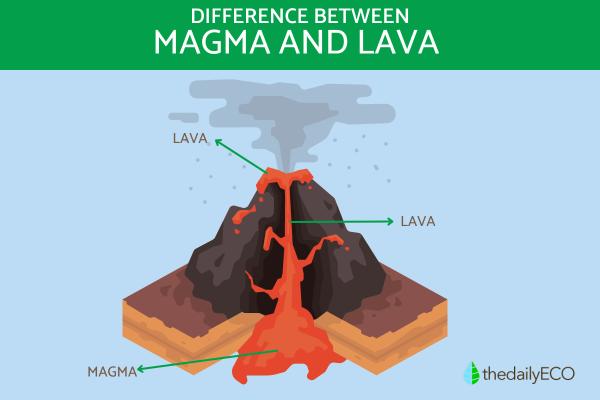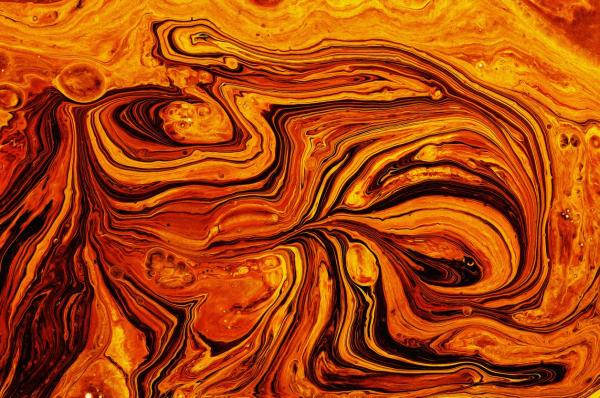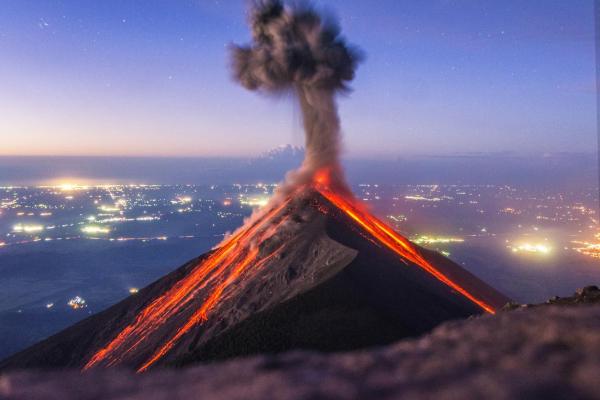What Is the Difference Between Lava and Magma?


It is not uncommon for people to confuse lava and magma, as both are molten rock materials often associated with volcanic activity. Also, since they have similar chemical compositions, people typically use the terms interchangeably. However, it is important to understand the differences between the two, as they have different properties and behaviors.
In this article from thedailyECO, we explain the differences between lava and magma, as well as their most significant characteristics.
What is magma?
Magma is a molten rock material found deep beneath the earth's surface. It is a complex mixture of liquid substances, volatile compounds, and solid particles formed by the melting of rocks in the Earth's mantle or crust due to high temperatures, pressure changes, or the presence of volatile substances such as water.
Magma is under intense pressure due to the weight of the overlying rock, which can affect its viscosity and gas content. As magma rises to the surface, the pressure decreases and the gas content may increase, resulting in the formation of bubbles or vesicles in the magma. When the pressure decreases rapidly, such as during a volcanic eruption, the gas can expand rapidly and lead to explosive eruptions.
The composition of magma varies depending on various factors such as temperature, pressure, minerals and more. In general, magma is divided into two types based on its mineral composition: mafic and felsic.
- Mafic magmas: also known as basic magmas, are rich in iron and magnesium silicates and have low silica content. These magmas are formed by the melting of the heavy crust of the seafloor and are characterized by their high temperature of 900ºC to 1200ºC and their ability to flow easily.
- Felsic magmas: also known as acidic magmas, have a high silica content in the form of silicates rich in sodium and potassium. These magmas are formed by melting of the continental crust and have a low temperature of 650ºC to 800ºC. Due to their high silica content, felsic magmas are very viscous and do not flow easily.
Both mafic and felsic magmas have high temperatures. When they cool and solidify, they form igneous rocks, which fall into two categories:
- Plutonic or intrusive rocks: are formed when magma solidifies in the Earth's interior, and they are generally coarse-grained due to slow cooling.
- Volcanic or effusive rocks: are formed when magma solidifies at the Earth's surface. Due to rapid cooling, they are usually fine-grained or glassy.
Magma is found in magma chambers, which are large underground pockets of magma. These chambers can be located at various depths in the Earth's crust, from a few kilometers to several tens of kilometers deep. The composition of the magma can vary depending on the location and type of molten rock.

What is lava?
Lava is the molten rock material that is erupted from a volcano or fissure onto the Earth's surface. It is the result of magma that has reached the Earth's surface through a volcanic eruption. Once the magma reaches the surface, it is called lava and can flow downhill, creating lava flows that can cover large areas.
A key difference between magma and lava is that lava is exposed to atmospheric pressure, which causes the gasses contained in the magma to be released during the eruption.
Lava can be either mafic or felsic depending on its mineral composition, and it can have different textures depending on how quickly it cools. Lava is typically very hot, with temperatures ranging from 700 to 1200°C, and can cause significant damage to the surrounding area if it flows quickly and uncontrollably.
In addition, the ambient temperature has a significant effect on the properties of lava as it cools rapidly and solidifies into volcanic or effusive rock. Therefore, the texture and appearance of lava flows can vary depending on the ambient temperature and rate of cooling.
You may be interested in this other article where we explain what volcanoes are and what causes a volcano to erupt.

What are the differences between magma and lava?
By now, you must have noticed the distinction between magma and lava. To summarize their main differences, keep the following aspects in mind:
Location
This is possibly the most significant difference between the two. Magma is found beneath the Earth's surface, while lava is the magma that has erupted onto the Earth's surface.
Exposure to external factors
Magma is subject to high pressure and temperature, which keeps it in a molten state beneath the Earth's crust. Lava, on the other hand, is subject to atmospheric pressure and ambient temperatures as it flows across the Earth's surface, which can cause it to solidify and cool.
Composition
Another key difference between magma and lava is their composition. Magma can have different mineral compositions depending on the specific location and geological activity that produced it. Lava retains the same mineral composition as the magma it originated from.
Physical properties
Finally, magma and lava have different physical properties. Magma is denser than lava because of the pressure it is subjected to beneath the earth's surface. Lava, on the other hand, has a lower density and is more fluid, allowing it to flow above the Earth's surface. Lava can also cool and solidify faster than magma, which can result in different textures and rock types.
Despite the fact that magma and lava possess some similarities as molten rock materials, their locations, compositions, and physical properties differ greatly.
Do not miss the video we leave below explaining how volcanoes are formed.

If you want to read similar articles to What Is the Difference Between Lava and Magma?, we recommend you visit our Facts about nature category.
- Sigurdsson, H., Houghton, B., McNutt, S., Rymer, H., & Stix, J. (Eds.). (2015). The encyclopedia of volcanoes.







